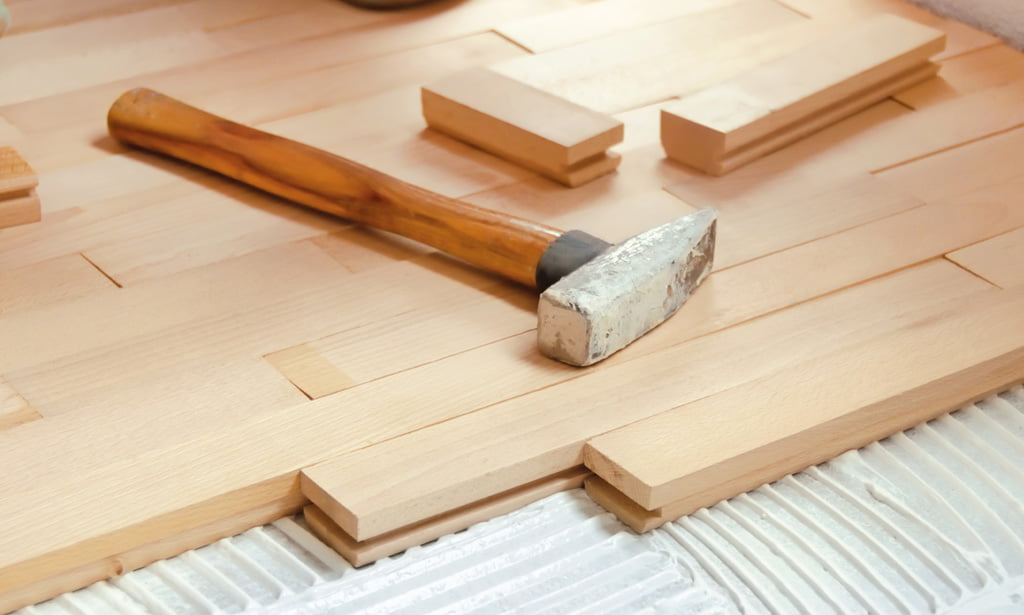Delamination from the substrate, timber movement, drummy spots and even timber splitting are symptoms commonly associated with timber floor issues related to adhesive failure; which begs the question “What’s causing the adhesive to fail?”
In my long career I have only encountered one genuine incidence of adhesive failure, otherwise almost all other timber floor issues related to adhesive failure could be attributed to human error,
poor bond strength or lack of adhesion having been traced back to the application method, wrong trowel/notch size or shape, the wrong spread rate, failure to bed the flooring into the adhesive or surface contamination and incompatibility with other products used.
Adhesive manufacturers are united in their interpretation of product use and limitations, which are clearly described on each product’s container, and expanded on in a collective statement by adhesive manufacturers to address sub-floor preparation which states: Surfaces must be clean, dry and free of voids, curing compounds, loose materials, oil, grease and sealers. Where previous adhesives (PVA or Bituminous adhesives) or combination (wax, coatings etc.) is suspected or in evidence, thorough removal of all such contamination must be carried out. All surfaces must be structurally sound and level before application. (Concrete slabs shall be in accordance with AS2870 Residential Footing and Slab Code).
Recommendations, instructions, specifications and technical date sheets put in place to inform practitioners following the recommended instructions will ensure that the product performs as intended. And yet, when it comes to applying adhesive products the application recommendations are often compromised.
Surface observations as cited in the manufacturer’s statement are usually visual, easily identified and remedied when necessary by grinding, levelling and patching. However, identifying the presence of invisible elements such as curing compounds and vapour barriers requires some testing. While in the past a simple bead test (droplet of water) would suffice to determine if a slab is porous, our evolving knowledge of curing compounds and vapour barriers and their impact on concrete bound moisture requires more quantitative strategies such as relative humidity (moisture) and pH testing.
A concrete slab is considered dry when it meets Standard ASTM F2170 which states: Concrete substrates shall be considered sufficiently dry when measurements taken at 40% depth of the substrate do not exceed 75% relative humidity (relative humidity testing). Industry recommends the application of a moisture barrier for all new and ground floor slabs; it’s also recommended that you use the same brands of barrier and adhesive.
High alkalinity in concrete is now recognised as being a potential cause of adhesive bond between product and the substrate. Changes in concrete manufacture and the current flooring technology have made pH testing of the substrate a critical factor. Test to measure the acid and alkaline content of concrete substrates – a neutral pH is 7; anything above 7 is alkaline anything below is acid. Concrete substrate is considered suitable for the installation of flooring and associated products when the pH does not exceed 10. Ideally the concrete and flooring moisture barrier/adhesive pH must be compatible.
When it comes to spreading adhesive, the correct trowel notch is critical in achieving the optimum spread rate and ensuring the adhesive will perform to specification. The manufacturers of each timber flooring adhesive recommend the trowel size and notch profile necessary to achieve the appropriate coverage. On average this ranges between 1.0 to 1.3m2 per litre/kilogram. Also critical to achieving correct coverage is the angle at which the trowel is held – when applied incorrectly the bond strength is compromised. Many installers spread the adhesive with a trowel held at a 45 degree angle, reducing adhesive coverage and compromising the adhesive bond.
The application of adhesive will only achieve warranted by the manufacturer when applied using a trowel held at 90 degrees to the substrate. The following picture illustrates the correct application compared to the picture on the below where the application of adhesive is compromised.

It is recommended that when placing timber into the adhesive that the board be lifted back to confirm the transfer of adhesive as shown in the following picture.

Should adhesive transfer be inadequate the bond strength will be severely compromised as seen in the following picture.

Full application and floor pressure must be maintained to achieve a maximum bond between the flooring and substrate. If using mechanical fixings to achieve bond, it is advisable to consult the end user for their approval.
Products for direct sticking timber to substrates carry concise and well written application instructions and/or procedures and when correctly applied and used as recommended they will perform to expectation.
In closing, I’d like to say that mastering the correct use of a trowel can be difficult for some, challenging for others and almost impossible for a few; but where there is a will there is a way. This trowel, while still meeting the manufacturer’s specification, has been modified to overcome such eventualities.
Ray and Sharon Brice specialise in mediation training and project management. They have four decades of experience in the flooring industry.
Phone: 0407 591 697 | Email: rayandsharon@timbertradernews.com










